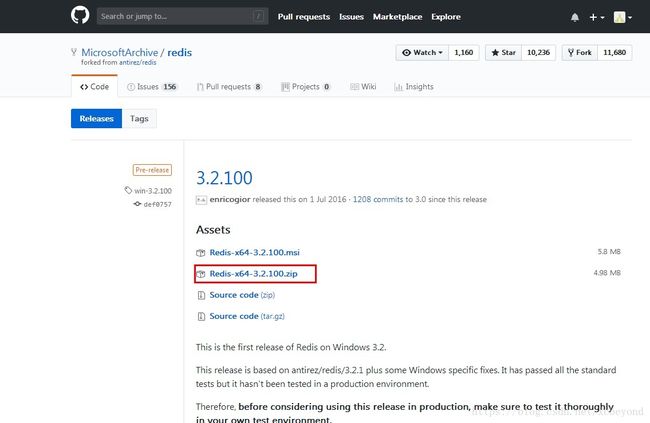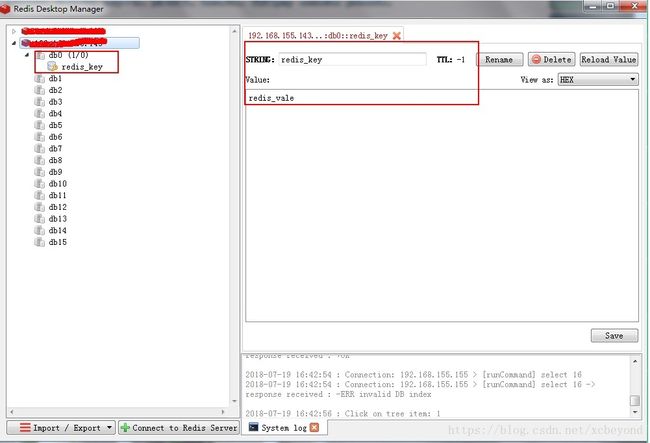【SpringBoot系列】七、SpringBoot 中使用Redis缓存
在项目中对数据的访问往往都是直接访问数据库的方式,但如果对数据的访问量很大或者访问很频繁的话,将会对数据库来很大的压力,甚至造成数据库崩溃。为了解决这类问题redis数据库脱颖而出,redis数据库出现时是以非关系数据库的光环展示在广大程序猿的面前的,后来redis的迭代版本支持了缓存数据、登录session状态(分布式session共享)等。所以又被作为内存缓存的形式应用到大型企业级项目中。
本章节主要讲述如何在SpringBoot项目中使用Redis。
1、Redis简单介绍
Redis 是完全开源免费的,遵守BSD协议,是一个高性能的key-value非关系性数据库(NoSql)。
Redis 与其他 key - value 缓存产品有以下三个特点:
- Redis支持数据的持久化,可以将内存中的数据保存在磁盘中,重启的时候可以再次加载进行使用。
- Redis不仅仅支持简单的key-value类型的数据,同时还提供list,set,zset,hash等数据结构的存储。
- Redis支持数据的备份,即master-slave模式的数据备份。
1.1 数据结构介绍
Redis可以存储键与5种不同数据结构类型之间的映射,这5种数据结构类型分别为String(字符串)、List(列表)、Set(集合)、Hash(散列)和 Zset(有序集合)。
| 结构类型 | 结构存储的值 | 读写能力 |
| String | 可以是字符串、整数或者浮点数 | 对整个字符串或者字符串的其中一部分执行操作;对象和浮点数执行自增(increment)或者自减(decrement) |
| List | 一个链表,链表上的每个节点都包含了一个字符串 | 从链表的两端推入或者弹出元素;根据偏移量对链表进行修剪(trim);读取单个或者多个元素;根据值来查找或者移除元素 |
| Set | 包含字符串的无序收集器(unorderedcollection),并且被包含的每个字符串都是独一无二的、各不相同 | 添加、获取、移除单个元素;检查一个元素是否存在于某个集合中;计算交集、并集、差集;从集合里卖弄随机获取元素 |
| Hash | 包含键值对的无序散列表 | 添加、获取、移除单个键值对;获取所有键值对 |
| Zset | 字符串成员(member)与浮点数分值(score)之间的有序映射,元素的排列顺序由分值的大小决定 | 添加、获取、删除单个元素;根据分值范围(range)或者成员来获取元素 |
2.2 Redis 优势
- 性能极高 – Redis能读的速度是110000次/s,写的速度是81000次/s 。
- 丰富的数据类型 – Redis支持二进制案例的 Strings, Lists, Hashes, Sets 及 Ordered Sets 数据类型操作。
- 原子 – Redis的所有操作都是原子性的,意思就是要么成功执行要么失败完全不执行。单个操作是原子性的。多个操作也支持事务,即原子性,通过MULTI和EXEC指令包起来。
- 丰富的特性 – Redis还支持 publish/subscribe, 通知, key 过期等等特性。
2.3 Redis与其他key-value存储有什么不同?
- Redis有着更为复杂的数据结构并且提供对他们的原子性操作,这是一个不同于其他数据库的进化路径。Redis的数据类型都是基于基本数据结构的同时对程序员透明,无需进行额外的抽象。
- Redis运行在内存中但是可以持久化到磁盘,所以在对不同数据集进行高速读写时需要权衡内存,因为数据量不能大于硬件内存。在内存数据库方面的另一个优点是,相比在磁盘上相同的复杂的数据结构,在内存中操作起来非常简单,这样Redis可以做很多内部复杂性很强的事情。同时,在磁盘格式方面他们是紧凑的以追加的方式产生的,因为他们并不需要进行随机访问。
2、安装Redis
根据不同的需求下载Linux或Windows版本的,目前Redis官网只有Linux版本,但由于大多数开发者还是基于windows平台开发的,所有GitHub上的技术牛人基于linux平台下的Redis实现了windows版本,给windows开发带来了福音。
2.1 下载Windows版本Redis
直接访问github网址:https://github.com/MSOpenTech/redis/releases,下载最新的windows X64版本的压缩包,如下图所示:
下载第二个.zip,免安装,解压就直接可以用,解压后如下图:
2.2 启动Redis
redis.windows.conf为redis配置文件,相关参数可以在这里配置,如:端口等,我这里使用默认参数,暂不修改,默认端口为6379。双击redis-server.exe启动,则出现如下图所示,则启动成功。
3、SpringBoot中使用Redis
以之前构建的项目为基准,使用Redis.
3.1 添加Redis依赖包
在项目的pom.xml中添加如下:
org.springframework.boot
spring-boot-starter-data-redis
3.2 配置Redis数据库连接
在application.properties中配置redis数据库连接信息,如下:
#redis配置
#Redis服务器地址
spring.redis.host=127.0.0.1
#Redis服务器连接端口
spring.redis.port=6379
#Redis数据库索引(默认为0)
spring.redis.database=0
#连接池最大连接数(使用负值表示没有限制)
spring.redis.jedis.pool.max-active=50
#连接池最大阻塞等待时间(使用负值表示没有限制)
spring.redis.jedis.pool.max-wait=3000
#连接池中的最大空闲连接
spring.redis.jedis.pool.max-idle=20
#连接池中的最小空闲连接
spring.redis.jedis.pool.min-idle=2
#连接超时时间(毫秒)
spring.redis.timeout=50003.3 编写Redis操作工具类
将RedisTemplate实例包装成一个工具类,便于对redis进行数据操作。
com.xcbeyond.springboot.redis.RedisUtils.java
package com.xcbeyond.springboot.redis;
import org.springframework.beans.factory.annotation.Autowired;
import org.springframework.data.redis.core.RedisTemplate;
import org.springframework.stereotype.Component;
/**
* redis操作工具类.
* (基于RedisTemplate)
* @author xcbeyond
* 2018年7月19日下午2:56:24
*/
@Component
public class RedisUtils {
@Autowired
private RedisTemplate redisTemplate;
/**
* 读取缓存
*
* @param key
* @return
*/
public String get(final String key) {
return redisTemplate.opsForValue().get(key);
}
/**
* 写入缓存
*/
public boolean set(final String key, String value) {
boolean result = false;
try {
redisTemplate.opsForValue().set(key, value);
result = true;
} catch (Exception e) {
e.printStackTrace();
}
return result;
}
/**
* 更新缓存
*/
public boolean getAndSet(final String key, String value) {
boolean result = false;
try {
redisTemplate.opsForValue().getAndSet(key, value);
result = true;
} catch (Exception e) {
e.printStackTrace();
}
return result;
}
/**
* 删除缓存
*/
public boolean delete(final String key) {
boolean result = false;
try {
redisTemplate.delete(key);
result = true;
} catch (Exception e) {
e.printStackTrace();
}
return result;
}
}
3.4 测试
写一个测试用例类来完成对redis的读写。
/springboot/src/test/java/com/xcbeyond/springboot/redis/RedisTest.java
package com.xcbeyond.springboot.redis;
import javax.annotation.Resource;
import org.junit.Test;
import org.junit.runner.RunWith;
import org.springframework.boot.test.context.SpringBootTest;
import org.springframework.test.context.junit4.SpringJUnit4ClassRunner;
/**
*
* @author xcbeyond
* 2018年7月19日下午3:08:04
*/
@RunWith(SpringJUnit4ClassRunner.class)
@SpringBootTest
public class RedisTest {
@Resource
private RedisUtils redisUtils;
/**
* 插入缓存数据
*/
@Test
public void set() {
redisUtils.set("redis_key", "redis_vale");
}
/**
* 读取缓存数据
*/
@Test
public void get() {
String value = redisUtils.get("redis_key");
System.out.println(value);
}
}
执行完测试方法set后,可以登录到redis上查看数据是否插入成功。
(建议使用RedisDesktopManager可视化工具进行查看)
4、总结
本章节只是简单的介绍了下在SpringBoot中如何使用Redis,Redis的使用远远不止这些,根据实际项目需求将会变得更加复杂,其中事物等都是可以通过redis来处理的。
本章节代码已提交至Github(https://github.com/xcbeyond/micro-service/tree/master/springboot),如有需要自行下载。




